 To enhance service speed and avoid tariff delays, we've opened a US warehouse. All US orders ship directly from our US facility.
To enhance service speed and avoid tariff delays, we've opened a US warehouse. All US orders ship directly from our US facility.
| Cat. No. | Product Name | Field of Application | Chemical Structure |
|---|---|---|---|
| DC39030 | SR-717 (lithium salt) Featured |
SR-717 is a non-nucleotide STING agonist with EC50s of 2.1 μM and 2.2 μM in ISG-THP1 (WT) and ISG-THP1 cGAS KO (cGAS KO) cell lines, respectively. SR-717 is a stable cyclic guanosine monophosphate-adenosine monophosphate (cGAMP) mimetic.
More description
|

|
| DC11803 | GLPG-1690(Ziritaxestat) Featured |
GLPG-1690 is a first-in-class, potent, competitive autotaxin inhibitor with Ki/IC50 of 15 nM/131 nM.
More description
|

|
| DC74567 | SWTX-143 Featured |
SWTX-143 is a potent, irreversible and covalent YAP/TAZ-TEAD inhibitor with IC50 of 12 nM in luciferase reporter assays, binds to the palmitoylation pocket of all four TEAD isoforms, inhibits Hippo pathway-mutant cancer cells.
More description
|
.gif)
|
| DC45679 | 2-Amino-2-deoxyglucose hydrochloride Featured |
2-Amino-2-deoxyglucose hydrochloride is a hexosamine hydrochloride can be used in the synthesis of cyclopropene-modified hexosamine derivative Ac4GlcNCyoc and Ac4GalNCyoc.
More description
|
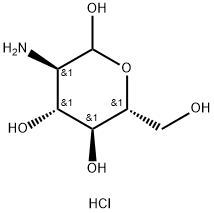
|
| DC10876 | H-151 Featured |
H-151(H151) is a novel STING (stimulator of interferon genes) antagonist.
More description
|

|
| DC70638 | NAMPT activator (NAT-5r) Featured |
NAMPT activator (NAT-5r) is a potent, small molecule activator of nicotinamide phosphoribosyltransferase (NAMPT) with ITC KD of 180 nM, 3-fold improved activity over NAT.NAMPT activator (NAT-5r) had no effect on NMNAT1 enzyme activity, both NAMPT mutants of K189R and K189A reduced the binding affinity of NAT-5r.NAMPT activator (NAT-5r) treatment significantly enhanced NAD content in NAMPT-WT cells, but not in NAMPT-CRISPR cells.Treatment of NAT-5r at 3 μM concentrations for 4 h induced significant elevation of cellular NAD.NAMPT activator (NAT-5r) induced subsequent metabolic and transcriptional reprogramming, promoted proliferation and maintain the self-renewal of NSCs and protects peripheral sensory neurons from paclitaxel-(PTX) induced damage in mouse model.
More description
|
.gif)
|
| DC11778 | PKC-IN-6c Featured |
A novel, potent, brain permeant PKC inhibitor with IC50 of 80 nM, without detectable binding to the estrogen receptor (Ki>10 uM).
More description
|

|
| DC60861 | Dexamethasone Acid Featured |
(-)-Dexamethasone Acid, also known as (11β,16α,17α)-9-Fluoro-11,17-dihydroxy-16-methyl-3-oxoandrosta-1,4-diene-17-carboxylic acid, is a synthetic glucocorticoid. It is a fluorinated steroid and a key intermediate in the synthesis of dexamethasone, a widely used anti-inflammatory and immunosuppressant medication.
More description
|

|
| DC74298 | BC18630 Featured |
BC18630 (BC 18630) is a small molecule inhibitor of the E3 ubiquitin ligase subunit DCAF7, potently inhibits SARS-CoV-2 infection with IC50 of 39 nM in cell-based assays.
More description
|

|
| DC65619 | Lipid 11-A-M Featured |
LNP Lipid-8 (11-A-M) is an ionizable lipid, which can be used for lipid nanoparticles (LNP) to deliver siRNA to T cells without targeting to ligands. LNP LIPs-8 loaded with GFP siRNA (siGFP), and significantly causes GFP gene silencing in mice model.
More description
|

|
| DC60032 | 5H-1,2,4-Triazolo[4,3-a]azepine, 3-(2,5-dimethyl-1-phenyl-1H-pyrrol-3-yl)-6,7,8,9-tetrahydro- Featured |

|
|
| DC73220 | Allopole-A Featured |
Allopole-A is the first allosteric, specfic inhibitor of the noncatalytic polo-box domain (PBD) of PLK1 (Polo-like kinase 1) with IC50 of 2.5 nM in FP-based assays, Allopole-A is the active form of Allopole.
More description
|

|
| DC73659 | 3hi2one-G4 Featured |
3hi2one-G4 is a highly selective small molecule activator targeting GIRK4 homomeric channels, does not activate GIRK2, GIRK1/2 or GIRK1/4 channels.
More description
|
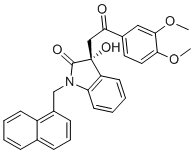
|
| DC74300 | BC18813 Featured |
BC18813 (BC 18813) is a small molecule inhibitor of the E3 ubiquitin ligase subunit DCAF7, potently inhibits SARS-CoV-2 infection with IC50 of 48 nM in cell-based assays.
More description
|

|
| DC71004 | Apaziquone Featured |
Apaziquone (EO-9), an analog of Mitomycin C, is a prodrug that is activated to DNA damaging species by oxidoreductases (particularly NQO1). Apaziquone has the ability to kill aerobic and/or hypoxic cancer cells. Apaziquone, a bioreductive alkylating agent, inhibits cell proliferation and induces apoptosis in oral squamous cell carcinoma (OSCC) cells. Apaziquone significantly reduces oral tumor xenograft volume in immunocompromised NOD/SCID/Crl mice.
More description
|
.gif)
|
| DC67562 | SMS121 Featured |
SMS121 is a CD36 inhibitor with a KD values of about 5 µM. SMS121 reduces the uptake of lipids and inhibits cell viability in acute myeloid leukemia cells. SMS121 has antitumor activity.
More description
|
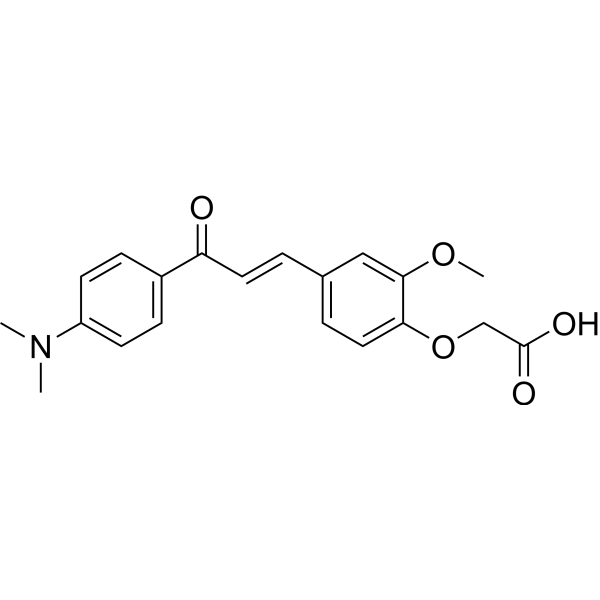
|
| DC67561 | Z57346765 Featured |
Z57346765 is a PGK1-specific inhibitor that reduces the activity of metabolic enzymes in PGK1 glycolysis and inhibits PGK1-dependent cell proliferation. Z57346765 exerts inhibitory effects against clear cell renal cell carcinoma (KIRC).
More description
|
.gif)
|
| DC47736 | Targeting the bacterial sliding clamp peptide 46 Featured |
Targeting the bacterial sliding clamp peptide 46 is a short peptide targeting the bacterial sliding clamp(SC), inhibiting SC-dependent DNA synthesis.
More description
|
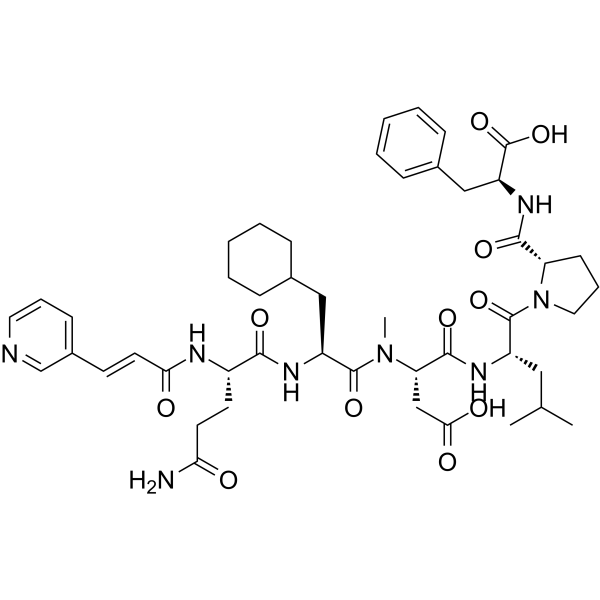
|
| DC60036 | SR-717 free acid Featured |
SR-717 is an agonist of stimulator of interferon genes STING for treating cancer. SR-717 demonstrates broad interspecies and interallelic specificity. SR-717 functions as a direct cyclic guanosine monophosphate-adenosine monophosphate (cGAMP) mimetic that induces the same "closed" conformation of STING. SR-717 displayed antitumor activity; promoted the activation of CD8+ T, natural killer, and dendritic cells in relevant tissues; and facilitated antigen cross-priming. SR-717 also induced the expression of clinically relevant targets, including programmed cell death 1 ligand 1 (PD-L1), in a STING-dependent manner.
More description
|

|
| DC67560 | SH514 Featured |
SH514 is a specific small molecule inhibitor of interferon regulatory factor 4 (IRF4) with IC50 of 2.63 uM, inhibits proliferation of IRF4-high-expressing NCI-H929 and MM.1R MM cells with IC50 of 0.08 uM and 0.11 uM, respectively.
More description
|
.gif)
|
| DC67559 | TDP1 Inhibitor-3 Featured |
TDP1 Inhibitor-3 (Compound 4E) is a (TDP1) inhibitor with an IC50 value of 0.63 μM.
More description
|
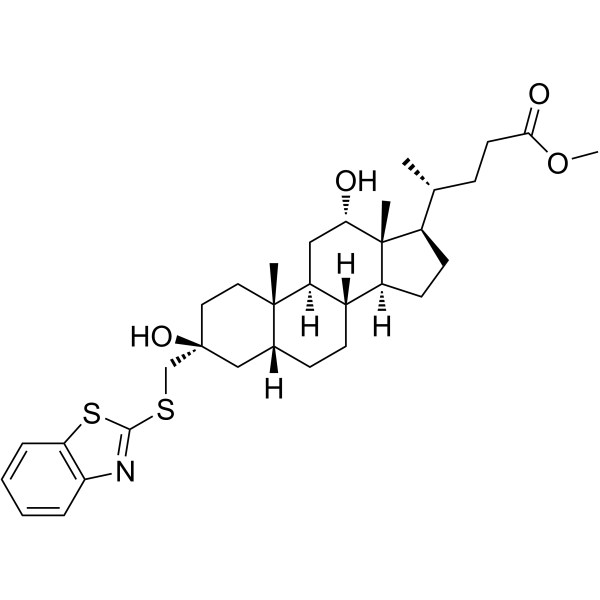
|
| DC65817 | VHL-CDO1 glue degrader ( Compound 4) Featured |
Compound 4 (VHL-CDO1 glue degrader) is a molecular glue degrader for cysteine dioxygenase 1 (CDO1) by recruiting it into the Von Hippel-Lindau (VHL) E3 ligase complex and leading to its selective degradation.
More description
|

|
| DC75325 | PSMA-617 TFA Featured |
PSMA-617, also know as vipivotide tetraxetan, is a ligand used to make 177Lu-PSMA-617, which is a radioactive molecule to fight cancer. PSMA617 possesses a small peptide, which was designed to target prostate-specific membrane antigen (PSMA). PSMA617 demonstrates high radiolytic stability for at least 72 h. PSMA617 has high inhibition potency (equilibrium dissociation constant Ki=2.34±2.94 nM on LNCaP; Ki=0.37±0.21 nM enzymatically determined). 177 Lu-PSMA-617 offers a potential additional life-prolonging treatment option for men with mCRPC.
More description
|

|
| DC70104 | Elacestrant Featured |
Elacestrant (RAD-1901) is a novel, orally bioavailable small-molecule selective estrogen receptor degrader (SERD).
More description
|

|
| DC32562 | PSMA617-TCMC TFA |
PSMA617-TCMC is a derivative of PSMA-617 with structure modification, in which the caroboxy groups in DOTA ring is replaced by TCMC macrocycle. PSMA-617 is a ligand used to make 177Lu-PSMA-617, which is a radioactive molecule to fight cancer,. PSMA-617 originally was developed at the German Cancer Research Center and the Heidelberg University Hospital. ABX held the exclusive license to bring the treatment, which targets prostate-specific membrane antigen (PSMA), through early clinical development.
More description
|
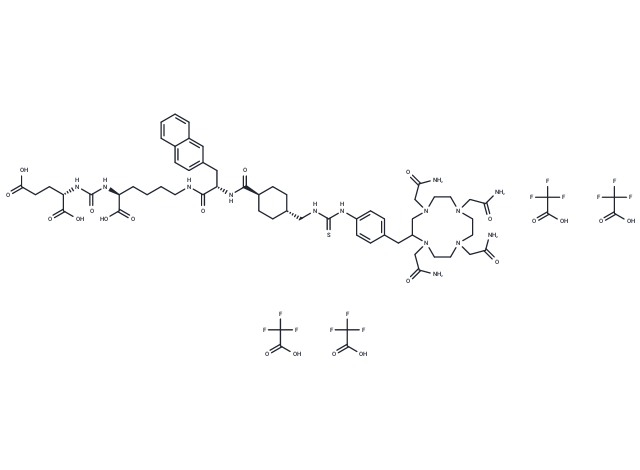
|
| DC60862 | ZSH-2208 Featured |
ZSH-2208 is a synthetic analog of all-trans retinoic acid (ATRA) designed to overcome resistance and improve differentiation therapy in acute promyelocytic leukemia (APL) and other malignancies. In published studies, ZSH-2208 has shown superior anti-proliferative and pro-differentiation activity compared to ATRA in ATRA-resistant APL cell lines such as NB4-R2. For example, ZSH-2208 induced significant G1 phase arrest and granulocytic differentiation in NB4-R2 cells at concentrations around 1–10 µM, whereas ATRA was largely ineffective at equivalent doses. In mouse xenograft models, ZSH-2208 treatment led to marked tumor growth inhibition without the rapid metabolic degradation seen with ATRA. These data suggest that ZSH-2208 is a promising candidate for treating retinoic acid-resistant leukemias and potentially other cancers sensitive to retinoid signaling.
More description
|

|
| DC73047 | JC19 Featured |
JC19 is a a cysteine-reactive small molecule degrader of SARS-CoV-2 nsp14 with DC50 of 8.7 uM in HEK293T cells.
More description
|

|
| DC70475 | H203 Featured |
H203 is a potent dual Mdm2/MdmX inhibitor with Ki of 2/11 nM, respectively;
H203 significantly reduced cell viability in the cells overexpressing both Mdm2 and MdmX, and a significant and dose-dependent decrease in cell number in H203-treated cells lacking Mdm2 or MdmX.
H203-mediated decrease in cell viability is strictly p53-dependent and H203 affects MdmX more specifically than nutlin-3a.
H203 induced the expression of the p21 gene but not the p53 gene in treated cancer cells.
More description
|

|
| DC74533 | ICT12035 Featured |
ICT12035 (AZ2158) is a potent, selective formylpeptide receptor-1 (FPR1) antagonist with IC50 of 30 nM in calcium mobilisation assays (100 nM fMLF).
More description
|

|
| DC73166 | Cyclin K degrader DS17 |
Cyclin K degrader DS17 is a selective cyclin K molecular glue degrader with TR-FRET EC50 of 19 nM.
More description
|

|